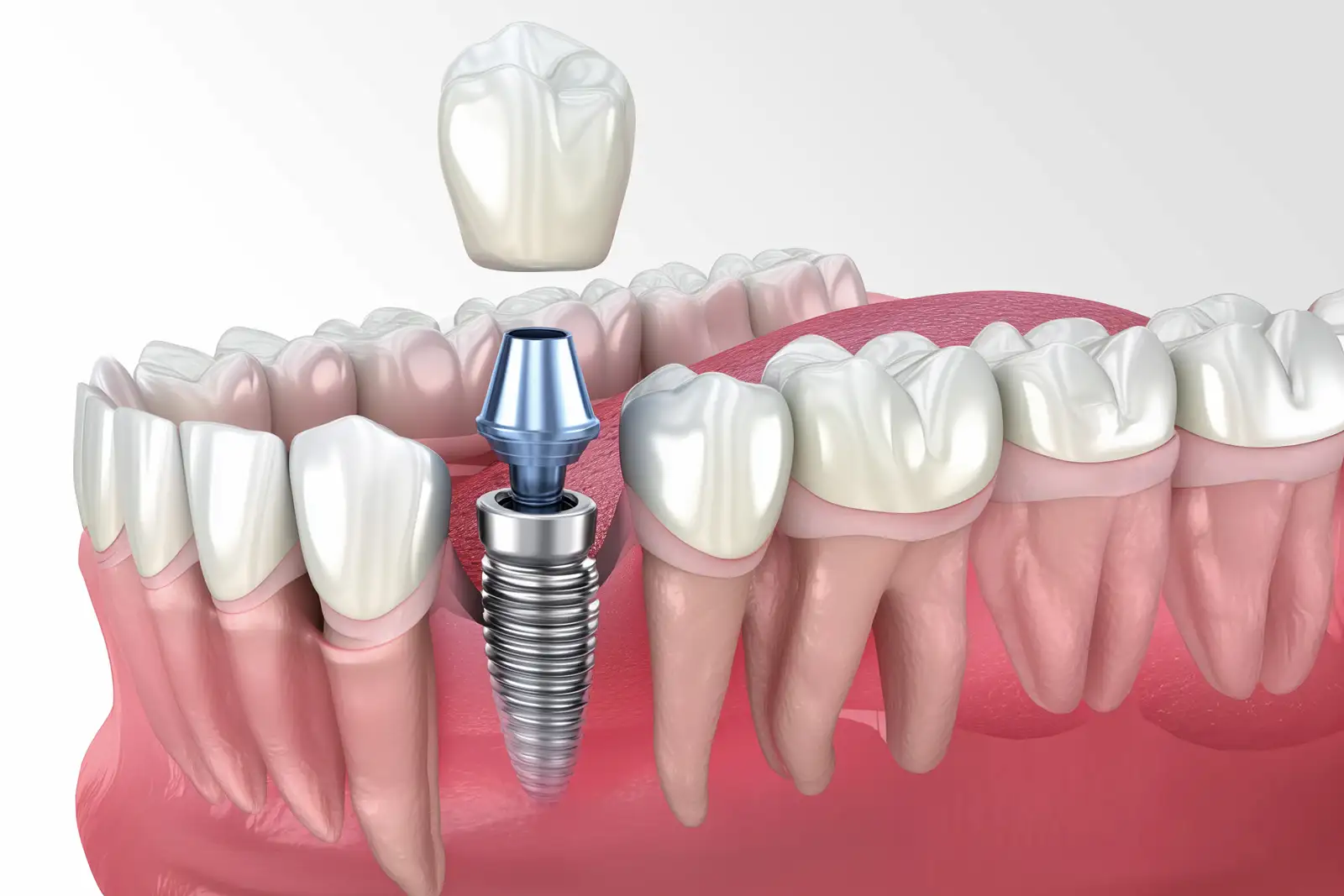Dental crown on an implant
A dental crown on an implant is intended for individuals missing a single tooth. It fully restores both the function and appearance of a natural tooth without affecting adjacent teeth

The implant replaces the tooth root, providing a stable foundation for a permanent crown that is carefully matched in color and shape to surrounding teeth and designed to last for many years.
What is a crown on a dental implant?
A crown on a dental implant is a prosthetic solution for replacing a missing tooth, offering a natural appearance and strength while restoring normal chewing function.
A biocompatible titanium implant acts as an artificial tooth root and serves as a stable support for the abutment and final crown.
Thanks to modern materials such as ceramic and zirconia, implant crowns can be made to look virtually indistinguishable from natural teeth.
Benefits of a crown on a dental implant
- Durable and stable replacement for a lost tooth
- Natural appearance and function similar to a real tooth
- Helps preserve bone mass and prevents gum recession
- Does not damage adjacent teeth
- Provides comfort and security without the risk of shifting
Who is a candidate for an implant crown?
An implant crown is an ideal solution for patients who have lost a single tooth due to:
- Tooth decay and its complications
- Periodontal disease (periodontitis, gingivitis)
- Traumatic injuries or accidents
- Congenital absence of a tooth (agenesis)
- Long-term use of removable dentures accompanied by bone loss
Candidates must have sufficient jawbone volume to support the implant. If the bone is insufficient, surgical procedures such as bone grafting (augmentation) or sinus lift may be required.
What is the procedure for getting a crown on an implant?
The process of placing a crown on a dental implant involves several stages to ensure a successful and long-lasting result:
1. First visit – Examination and treatment planning
- Clinical examination and oral health assessment
- X-rays or 3D CBCT imaging to evaluate bone condition
- Implant positioning and selection of crown material
Implant placement
- A titanium screw (implant) is inserted into the jawbone under local anesthesia
- The gum is stitched and the implant is left to integrate with the bone over 3–6 months (osseointegration)
2. Second visit – Placement of the abutment
- After successful osseointegration, the abutment is attached
- Precise dental impressions are taken for crown fabrication
3. Third visit – Final crown fabrication and placement
- In consultation with the patient, the crown is made from ceramic, zirconia, or metal-ceramic
- The crown is either cemented or screw-retained on the abutment
- The fit, appearance, and bite are carefully checked
A crown on a dental implant fully restores the natural tooth in both function and appearance while preserving the health of the surrounding bone and gums.
It helps maintain the structural integrity of the jaw and prevents gum recession and shifting of nearby teeth.
For a successful and lasting outcome, proper oral hygiene and regular dental checkups are essential.
Frequently asked questions about implant crowns
The entire process usually takes 3 to 6 months, including the time needed for the implant to integrate with the bone.
No, the implant placement is performed under local anesthesia, and any post-operative discomfort is typically mild.
Zirconia and ceramic are preferred for their natural aesthetics, while metal-ceramic is a more affordable option.
With good oral hygiene and regular checkups, a crown can last 10–20 years or longer.
Maintenance is similar to caring for natural teeth: regular brushing, flossing or use of interdental brushes, and routine dental visits.
Yes, though very hard foods should be avoided to prevent damage.
Implant failure is rare. Osseointegration may occasionally fail, but overall success rates are above 95%.
Costs vary based on the crown material and case complexity. A consultation with your dentist is the best way to get an accurate estimate.
Yes, if damaged, the crown can be replaced without removing the implant.
Screw-retained crowns are easier to remove for repairs, while cemented crowns provide better aesthetics.
Contact us
Our friendly team will be happy to listen to your requests.
